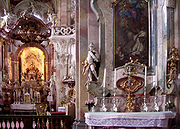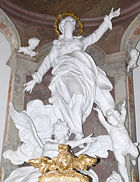
Joseph Anton Feuchtmayer
Encyclopedia

Rococo
Rococo , also referred to as "Late Baroque", is an 18th-century style which developed as Baroque artists gave up their symmetry and became increasingly ornate, florid, and playful...
stucco
Stucco
Stucco or render is a material made of an aggregate, a binder, and water. Stucco is applied wet and hardens to a very dense solid. It is used as decorative coating for walls and ceilings and as a sculptural and artistic material in architecture...
ist and sculptor
Sculpture
Sculpture is three-dimensional artwork created by shaping or combining hard materials—typically stone such as marble—or metal, glass, or wood. Softer materials can also be used, such as clay, textiles, plastics, polymers and softer metals...
, active in southern Germany and Switzerland.
J. A. Feuchtmayer was born in Linz
Linz
Linz is the third-largest city of Austria and capital of the state of Upper Austria . It is located in the north centre of Austria, approximately south of the Czech border, on both sides of the river Danube. The population of the city is , and that of the Greater Linz conurbation is about...
, a member of the famous Feuchtmayer
Feuchtmayer
The Feuchtmayers were a German family of artists from the Baroque Wessobrunner School....
family of the Wessobrunner School
Wessobrunner School
The Wessobrunner School is the name for a group of Baroque stucco-workers that, beginning at the end of the 17th century, developed in the Benedictine Wessobrunn Abbey in Bavaria, Germany....
. He was the son of Franz Joseph Feuchtmayer
Franz Joseph Feuchtmayer
Franz Joseph Feuchtmayer was a member of the German Feuchtmayer family of Baroque artists of the Wessobrunner School.Feuchtmayer was born in Wessobrunn Abbey...
(1660–1718); the nephew of Johann Michael Feuchtmayer
Johann Michael Feuchtmayer the Elder
Johann Michael Feuchtmayer was a German painter and copper engraver.He was born in Wessobrunn, into the famous Feuchtmayer family of Baroque artists associated with the Wessobrunner School....
(the Elder) and Michael Feuchtmayer
Michael Feuchtmayer
Michael Feuchtmayer was a member of the Feuchtmayer family of Baroque artists of the German Wessobrunner School.He was the brother of Franz Joseph Feuchtmayer and Johann Michael Feuchtmayer ; the father of Franz Xaver Feuchtmayer and Johann Michael Feuchtmayer ; the...
(b. 1667); the first cousin of Franz Xaver Feuchtmayer
Franz Xaver Feuchtmayer
Franz Xaver Feuchtmayer was a German Baroque stucco plasterer of the Wessobrunner School.A member of the famous Feuchtmayer family, he was the son of Michael Feuchtmayer Franz Xaver Feuchtmayer (the Elder) (1698, Wessobrunn, Bavaria – 1763) was a German Baroque stucco plasterer of the...
(the Elder) (1705–1764) and Johann Michael Feuchtmayer
Johann Michael Feuchtmayer
Johann Michael Feuchtmayer was a German Baroque stucco sculptor and plasterer of the Wessobrunner School, who worked alongside Johann Michael Fischer, Johann Joseph Christian, and Franz Joseph Spiegler to create some of the most famous churches along the Upper...
(the Younger) (1709–1772); and the first cousin once removed
Cousin
In kinship terminology, a cousin is a relative with whom one shares one or more common ancestors. The term is rarely used when referring to a relative in one's immediate family where there is a more specific term . The term "blood relative" can be used synonymously and establishes the existence of...
of Franz Xaver Feuchtmayer
Franz Xaver Feuchtmayer the Younger
Franz Xaver Feuchtmayer was a member of the German Feuchtmayer family of Baroque artists associated with the Wessobrunner School....
(the Younger) (b. 1735).
Joseph Anton began studying sculpture in Augsburg
Augsburg
Augsburg is a city in the south-west of Bavaria, Germany. It is a university town and home of the Regierungsbezirk Schwaben and the Bezirk Schwaben. Augsburg is an urban district and home to the institutions of the Landkreis Augsburg. It is, as of 2008, the third-largest city in Bavaria with a...
in 1715 and did work in Weingarten starting in 1718. After the death of his father Franz Joseph, he took over his father's workshop in Mimmenhausen. At the same time, he became the "house sculptor" of the monastery
Salem Abbey
Salem Abbey , also known as Salmansweiler and in Latin as Salomonis Villa, was a very prominent Cistercian monastery in Salem in the district of Bodensee about ten miles from Konstanz, Baden-Württemberg, Germany.-Abbey:The abbey was founded in 1136 by Gunthram of Adelsreute Salem Abbey (Kloster or...
in Salem, delivering for them his first commission, the organ case
Pipe organ
The pipe organ is a musical instrument that produces sound by driving pressurized air through pipes selected via a keyboard. Because each organ pipe produces a single pitch, the pipes are provided in sets called ranks, each of which has a common timbre and volume throughout the keyboard compass...
for the Salemer Münster
Salem Abbey
Salem Abbey , also known as Salmansweiler and in Latin as Salomonis Villa, was a very prominent Cistercian monastery in Salem in the district of Bodensee about ten miles from Konstanz, Baden-Württemberg, Germany.-Abbey:The abbey was founded in 1136 by Gunthram of Adelsreute Salem Abbey (Kloster or...
.
Feuchtmayer was influenced by (among others) the Italian stuccoist Diego Francesco Carlone
Diego Francesco Carlone
Diego Francesco Carlone was an Italian sculptor.Carlone was born in Scaria into a family of artists. His father owned a workshop where Carlone learned the sculpting trade and eventually inherited the business. The workshop produced stucco decorations for a number of churches in the neighboring...
, with whom he worked in Weingarten. From him, he learned the production techniques for creating the stucco figures with highly polished surfaces that would make Feuchtmayer famous.
Alongside such notable artists as Johann Joseph Christian
Johann Joseph Christian
Johann Joseph Christian was a German Baroque sculptor and woodcarver. His masterworks are considered to be the choir stalls in Zwiefalten Abbey and Ottobeuren Abbey....
and Franz Joseph Spiegler
Franz Joseph Spiegler
Franz Joseph Spiegler was a German Baroque painter. He is best known for his frescoes, which decorate many of the churches and monasteries along the Upper Swabian Baroque Route. The frescoes in the Zwiefalten Abbey are considered his masterpiece.Spiegler was born the Free Imperial City of Wangen...
, Feuchtmayer worked for the most part on the Baroque
Baroque architecture
Baroque architecture is a term used to describe the building style of the Baroque era, begun in late sixteenth century Italy, that took the Roman vocabulary of Renaissance architecture and used it in a new rhetorical and theatrical fashion, often to express the triumph of the Catholic Church and...
monastic churches along the Upper Swabian Baroque Route
Upper Swabian Baroque Route
The Upper Swabian Baroque Route is a touristic theme route through Upper Swabia, following the themes of "nature, culture, baroque". The route has a length of about 500 km . It was established in 1966, being one of the first theme routes in Germany...
. His most well-known work is the putto
Putto
A putto is a figure of an infant often depicted as a young male. Putti are defined as chubby, winged or wingless, male child figure in nude. Putti are distinct from cherubim, but some English-speakers confuse them with each other, except that in the plural, "the Cherubim" refers to the biblical...
on the Bernhardsaltar in Birnau
Überlingen
Überlingen is a city on the northern shore of Lake Constance . After the city of Friedrichshafen, it is the second largest city in the Bodenseekreis , and a central point for the outlying communities...
called the "Honigschlecker" ("honey eater"), a reference St. Bernard
Bernard of Clairvaux
Bernard of Clairvaux, O.Cist was a French abbot and the primary builder of the reforming Cistercian order.After the death of his mother, Bernard sought admission into the Cistercian order. Three years later, he was sent to found a new abbey at an isolated clearing in a glen known as the Val...
's rhetorical gift.
Feuchtmayer's house and workshop in Mimmenhausen, near Salem, Bodensee
Salem, Bodensee
Salem is a municipality in the Bodensee district of Baden-Württemberg in Southern Germany, located 9 km north of Lake Constance, with a population of c. 11,000.-Culture and sights:...
, where he died, are now a museum dedicated to the life and work of the artist.

Major works
- BeuronBeuronBeuron is a municipality in the district of Sigmaringen in Baden-Württemberg in Germany. Beuron is known for the Beuron Archabbey and the Beuron Art School for religious art.Beuron is divided into subdistricts :* Hausen im Donautal* Langenbrunn* Neidingen...
—Benedictine Abbey of St. Martin and St. MariaBeuron ArchabbeyBeuron Archabbey is a major house of the Benedictine Order located at Beuron in the upper Danube valley in Baden-Württemberg in Germany....
(high altar) - MeersburgMeersburgMeersburg is a town of Baden-Württemberg in the southwest of Germany at Lake Constance.It is famous for its charming medieval city. The lower town and upper town are reserved for pedestrians only and connected by two stairways and a steep street .-History:The name of the town means "Burg on the...
—Chapel in the Neues Schloss (stucco) - St. Peter im Schwarzwald—St. Peter's Abbey in the Black ForestSt. Peter's Abbey in the Black ForestSt Peter's Abbey in the Black Forest or St. Peter's Abbey, Schwarzwald is a former Benedictine monastery in the village of St. Peter im Schwarzwald, in the district of Breisgau-Hochschwarzwald, Baden-Württemberg, Germany.-History:...
(sculptures on pillars, Apostle figures on altars) - SalemSalem, BodenseeSalem is a municipality in the Bodensee district of Baden-Württemberg in Southern Germany, located 9 km north of Lake Constance, with a population of c. 11,000.-Culture and sights:...
—Cistercian Abbey ChurchSalem AbbeySalem Abbey , also known as Salmansweiler and in Latin as Salomonis Villa, was a very prominent Cistercian monastery in Salem in the district of Bodensee about ten miles from Konstanz, Baden-Württemberg, Germany.-Abbey:The abbey was founded in 1136 by Gunthram of Adelsreute Salem Abbey (Kloster or...
(four confessionals, organ case) - ÜberlingenÜberlingenÜberlingen is a city on the northern shore of Lake Constance . After the city of Friedrichshafen, it is the second largest city in the Bodenseekreis , and a central point for the outlying communities...
— Cistercian Priory of Birnau (window frames, Maria Immaculata, stucco, statue, altars, pulpit, altar figures, stations of the crossStations of the CrossStations of the Cross refers to the depiction of the final hours of Jesus, and the devotion commemorating the Passion. The tradition as chapel devotion began with St...
) - ÜberlingenÜberlingenÜberlingen is a city on the northern shore of Lake Constance . After the city of Friedrichshafen, it is the second largest city in the Bodenseekreis , and a central point for the outlying communities...
—Franziskanerkirche (high altar) - Weingarten—Benedictine Monastery of St. Martin of Tours and St. OswaldWeingarten AbbeyWeingarten Abbey or St. Martin's Abbey is a Benedictine monastery on the Martinsberg in Weingarten near Ravensburg in Baden-Württemberg .-First foundation:...
(choir stalls) - Wurznach—Catholic Parish Church of St. Verena (figures on high altar)
- Zeil, near Leutkirch im AllgäuLeutkirch im AllgäuLeutkirch im Allgäu is a city in south-eastern Baden-Württemberg, Germany. It is part of the district of Ravensburg, in the western, Württembergish part of the Allgäu region. It belongs to the administrative region of Tübingen....
—Catholic Parish Church of Mariä Himmelfahrt (high altar)

